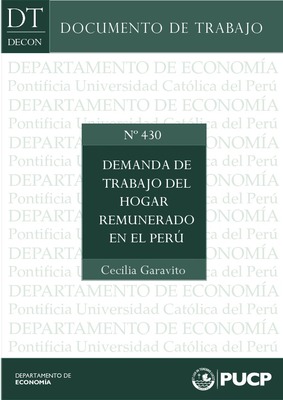| dc.contributor.author | Garavito, Cecilia | |
| dc.date.accessioned | 2018-06-28T15:21:32Z | |
| dc.date.available | 2018-06-28T15:21:32Z | |
| dc.date.issued | 2016-11 | |
| dc.identifier.uri | http://repositorio.pucp.edu.pe/index/handle/123456789/126762 | |
| dc.description.abstract | El objetivo de este trabajo es analizar la demanda de trabajo del hogar remunerado (THR) y su relación con la participación laboral y los ingresos de los miembros del hogar demandante, especialmente de las mujeres. Dado que la mayoría de las trabajadoras del hogar se encuentra en el sector urbano y que las tareas llevadas a cabo por estas trabajadoras son distintas en el sector rural, analizamos solamente la demanda de THR en el sector urbano. Para ello empleamos los datos de la Encuesta Nacional de Uso del Tiempo (ENNUT) y de la Encuesta Nacional de Hogares (ENAHO), para el año 2010, y encontramos que mientras las familias de mayores ingresos son las que demandan la mayoría del THR “cama adentro”, las familias donde los jefes de hogar son más jóvenes demandan en su mayoría THR “cama afuera”. Por medio de ecuaciones Logit binomial y multinomial encontramos que los ingresos laborales y no laborales del jefe de hogar como de la cónyuge tienen un efecto positivo sobre la probabilidad de demandar THR. Asimismo, el efecto marginal del ingreso de la cónyuge sobre la demanda de THR “cama afuera” es mayor que el efecto marginal del ingreso del jefe de hogar; sucede lo contrario con respecto a la demanda de THR “cama adentro”. Encontramos que la probabilidad de demandar THR es menor si la lengua materna del jefe de hogar es una lengua nativa. Finalmente, la probabilidad de demandar THR es mayor a más hijos menores de 6 años de edad, si bien el efecto marginal es mayor para el caso del THR “cama adentro” en relación a la demanda de THR “cama afuera”.
The aim of this work is to analyze paid house-work (PHW) and its relation with the demanding family’s labor participation and, especially the women’s. Given that the majority of paid house-workers are in the urban sector, and that the house-work in the rural sector is different, we only analyze the PHW in the urban sector. We use the data from the Encuesta Nacional de Uso del Tiempo (ENNUT) and from the Encuesta Nacional de Hogares (ENAHO), for the year 2010, and we find that while the families with larger income demand the majority of the “live-in” PHW, those families with younger heads of household demand preferably “live-out” PHW. By means of Binomial and Multinomial Logit estimations we find that the labor and non-labor income from the head of household and the spouse have a positive effect on the probability of demanding PHW. We also found that the marginal effect of the spouse’s income over the demand of “live-out” PHW is greater than the head of household’s income; it is the other way round with the demand for “live-in” PHW. We find that the probability of demanding PHW is lower if the head of household speaks a native language. Finally, the probability of demanding PHW is higher when there are more children under 6 years old in the family, though the marginal effect is higher in the case of the demand for “live-in” PHW than for the “live-out” PHW. | en_US |
| dc.language.iso | spa | es_ES |
| dc.publisher | Pontificia Universidad Católica del Perú. Departamento de Economía | es_ES |
| dc.relation.ispartof | urn:issn:2079-8466 | |
| dc.relation.ispartof | urn:issn:2079-8474 | |
| dc.rights | info:eu-repo/semantics/openAccess | es_ES |
| dc.rights.uri | http://creativecommons.org/licenses/by-nc-nd/2.5/pe/ | * |
| dc.subject | demanda de trabajo | es_ES |
| dc.subject | Género | es_ES |
| dc.subject | Mercado de trabajo | es_ES |
| dc.subject | Trabajo del hogar remunerado | es_ES |
| dc.subject | labor demand | es_ES |
| dc.subject | Gender | es_ES |
| dc.subject | Labor Market | es_ES |
| dc.subject | Paid House-Work | es_ES |
| dc.title | Demanda de trabajo del hogar remunerado en el Perú | es_ES |
| dc.type | info:eu-repo/semantics/workingPaper | |
| dc.type.other | Documento de trabajo | |
| dc.subject.ocde | http://purl.org/pe-repo/ocde/ford#5.02.00 | |
| dc.publisher.country | PE | |
| renati.advisor.orcid | https://orcid.org/0000-0001-6800-433X | |


